|
Scientific Name | Erica bauera Andrews subsp. gouriquae E.G.H.Oliv. & I.M.Oliv. |
Higher Classification | Dicotyledons |
Family | ERICACEAE |
National Status |
Status and Criteria | Critically Endangered B1ab(iii,v) |
Assessment Date | 2022/05/25 |
Assessor(s) | E.G.H. Oliver, A.L. Schutte-Vlok, R.C. Turner, L. von Staden & J. Potgieter |
Justification | A restricted range endemic from Stilbaai to Gouritsmond in the Western Cape Province, South Africa, with an extent of occurrence (EOO) of 55 km². Plants at two known locations are declining due to habitat loss to crop cultivation and competition from alien invasive plants. The population is severely fragmented as both known subpopulations are small, isolated and declining. This species therefore qualifies for listing as Critically Endangered under criterion B. |
Distribution |
Endemism | South African endemic |
Provincial distribution | Western Cape |
Range | This species is distributed from Stilbaai to Gouritsmond. |
Habitat and Ecology |
Major system | Terrestrial |
Major habitats | Canca Limestone Fynbos, Hartenbos Dune Thicket |
Description | Plants grow in sandy areas between limestone hills in Canca Limestone Fynbos. |
Threats |
| This subspecies appears to be endemic to Canca Limestone Fynbos, a vegetation type which is not currently extensively transformed, although crop cultivation appears to be expanding rapidly in the area between Albertinia and Stilbaai, where this species was recorded in 2007. At one of the known locations, a private nature reserve, plants are threatened by competition from alien invasive plants. These were cleared before 2005, but currently there are still quite a lot of aliens, predominantly wattles and pines, requiring ongoing management and clearing. There has also been clearing of the fynbos for road upgrades which has caused a decline to the number of individuals between 2018 and 2021. |
Population |
This subspecies, which was discovered in 2001, was previously known from a single location in a private nature reserve west of Gouritsmond, where the taxon was recorded to be locally frequent. In 2007, the population size was estimated to be fewer than 500 mature individuals. On a visit to the site (2012), only two mature individuals could be found, at one of the stands but the site had recently burnt, and the subpopulation of this reseeder was at the time suspected to be regenerating. No plants could be found at the same site in 2021 and the plants are suspected to have been lost to the construction of a service road. A handful of plants known from a second stand in the central part of the reserve that were observed between 2008 and 2012 could also not be found in 2021. Despite the site burning in 2012 there seems to have been little to no recruitment and the number of plants in the entire subpopulation is suspected to be fewer than 50 plants. In 2007, a plant belonging to this subspecies was collected north of Stilbaai, significantly extending the known range of this taxon, and raising the possibility that it may be more widespread within Canca Limestone Fynbos than previously thought. More surveys are needed to determine the extent of the population. However, current data indicate that the subpopulations are small, isolated and decling.
|
Population trend | Decreasing |
Assessment History |
Taxon assessed |
Status and Criteria |
Citation/Red List version | | Erica baueri Andrews subsp. gouriquae E.G.H.Oliv. & I.M.Oliv. | CR B1ab(iii) | 2012.1 | | Erica baueri Andrews subsp. gouriquae E.G.H.Oliv. & I.M.Oliv. | CR B1ab(iii) | Raimondo et al. (2009) | |
Bibliography |
Oliver, E.G.H. and Oliver, I.M. 2002. The genus Erica (Ericaceae) in southern Africa: taxonomic notes 1. Bothalia 32(1):37-61.
Raimondo, D., von Staden, L., Foden, W., Victor, J.E., Helme, N.A., Turner, R.C., Kamundi, D.A. and Manyama, P.A. 2009. Red List of South African Plants. Strelitzia 25. South African National Biodiversity Institute, Pretoria.
|
Citation |
| Oliver, E.G.H., Schutte-Vlok, A.L., Turner, R.C., von Staden, L. & Potgieter, J. 2022. Erica bauera Andrews subsp. gouriquae E.G.H.Oliv. & I.M.Oliv. National Assessment: Red List of South African Plants version 2024.1. Accessed on 2025/12/13 |
 Comment on this assessment
Comment on this assessment

